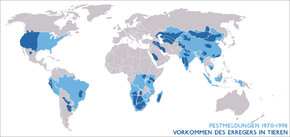Septicemic plague
![]()
The title of this article is ambiguous. For other meanings, see Plague (disambiguation).
Plague (Latin pestis "pestilence, epidemic, bubonic plague, plague", Ancient Greek λοιμός loimós; English plague), obsolete also called pestilence (Latin pestilentia), is a highly contagious infectious disease caused by the bacterium Yersinia pestis. It can take several forms, including bubonic plague (bubonic plague) and pneumonic plague. In Latin as well as ancient Greek, the words mentioned originally stood for any contagious disease.
Originally, the disease is a zoonosis, that is, a disease transmissible from animals to humans and vice versa, which came from rodents (marmots, rats, squirrels), in whose populations it can be enzootic. Transmission to humans is classically via the bite of an infected flea, but direct human-to-human infection via droplet infection is also possible.
There is now a vaccination against the pathogen, which is recommended by the WHO, however, only for risk groups. Treatment of an infection is possible with antibiotics, although resistance is increasingly being observed.
In Germany, Austria and Switzerland, plague is a notifiable disease.
As the so-called Black Death, the plague led to the most devastating epidemics in human history in the 14th century and with the Justinian Plague also already in the 6th century. A historical overview of the disease and other epidemics, also called plague, which claimed many lives, can be read under History of the Plague.

Reported cases of plague (1970-1998) Correlation with recorded incidence of plague in animals
Pathogen
Plague is caused in humans and animals by the bacterium Yersinia pestis (formerly subdivided into Yersinia pestis orientalis, Yersinia pestis antiqua and Yersinia pestis medievalis). This bacterium, a mutation of Yersinia pseudotuberculosis, which is relatively harmless to humans, is highly adaptable, and many different variants have been described. The pathogenic properties of Yersinia pestis result from ectotoxin, endotoxin and bacterial capsule formation.

Yersinia pestis
Occurrence
The spread of plague depends on the spread of intermediate hosts. Where they are found, plague cases are always possible. Whether these can grow into epidemics depends on several factors, such as resistance of the bacteria to drugs, the prevailing hygienic conditions and control of the local intermediate hosts.
Questions and Answers
Q: What is septicemic plague?
A: Septicemic plague is a deadly blood infection caused by the bacterium Yersinia pestis. It is one of the three main forms of plague, along with bubonic and pneumonic.
Q: How did septicemic plague spread in medieval times?
A: In medieval times, septicemic plague was mainly spread through the bite of an infected rodent or insect. In rare cases it could also enter the body through an opening in the skin or by cough from another infected human.
Q: What are some symptoms of septicemic plague?
A: Symptoms of septicemic plague include small blood clots throughout the body, red and/or black patchy rash, bumps on the skin that look like insect bites, coughing up or vomiting blood (hemoptysis/haemoptysis).
Q: How can septicemic plague be treated?
A: Treatment for septicemic plague includes antibiotics which can reduce death rate to between 4-15%. Early treatment within 24 hours is essential as without treatment it is almost always fatal.
Q: What percentage of people died from septicemic plague in medieval times?
A: The death rate for those who contracted septicemic plague in medieval times was 99-100 percent without treatment.
Q: Are there other forms of Plague besides Septicemia?
A: Yes, there are two other main forms of Plague besides Septicemia - Bubonic and Pneumonic Plague.
Search within the encyclopedia